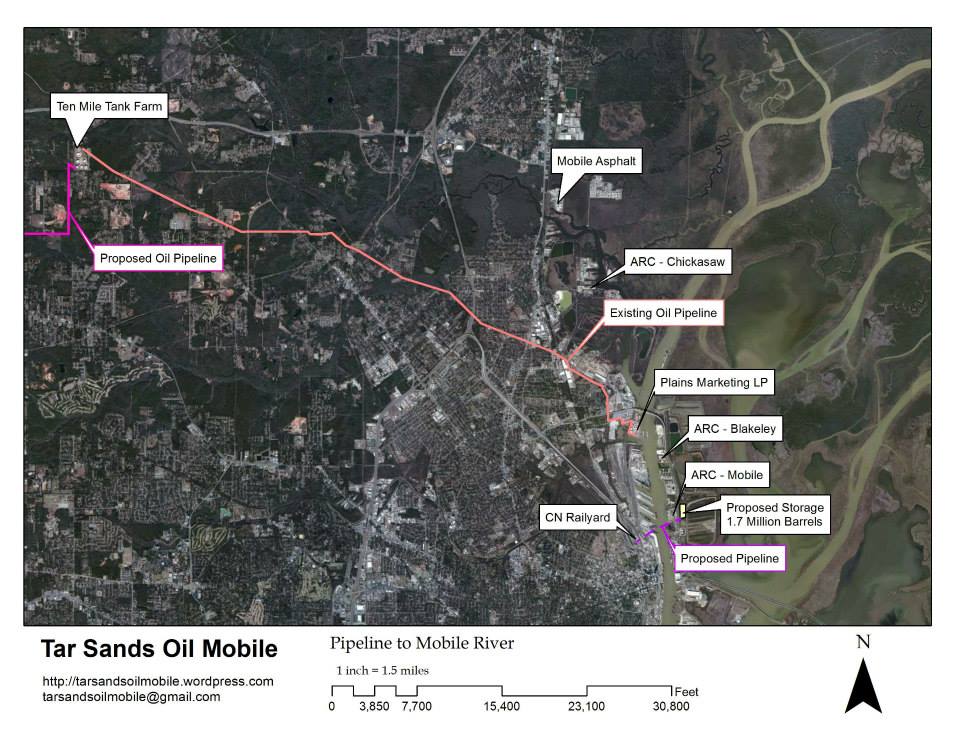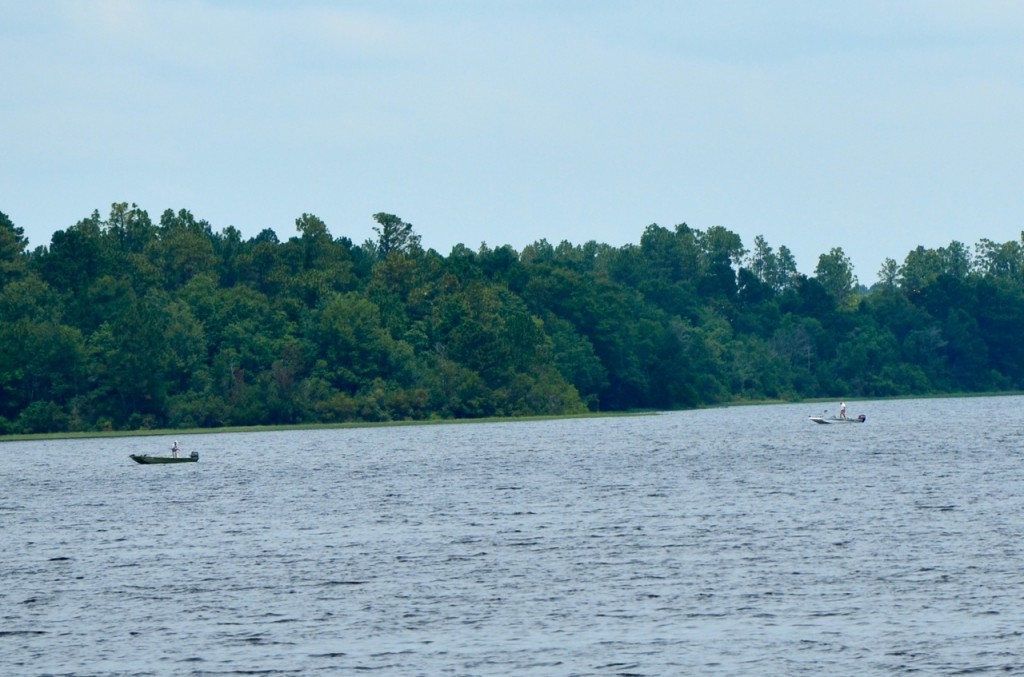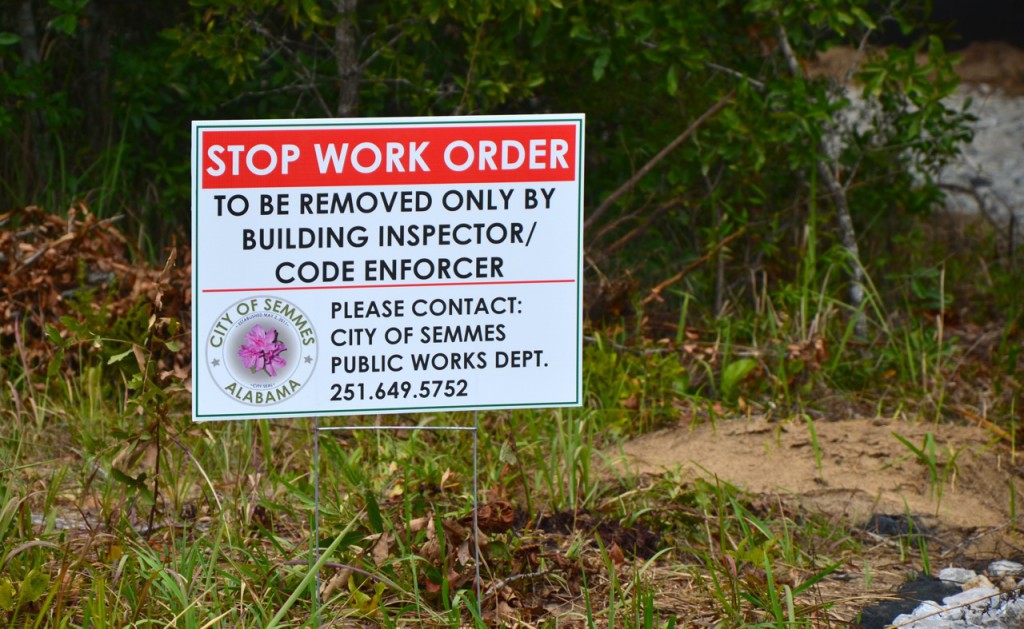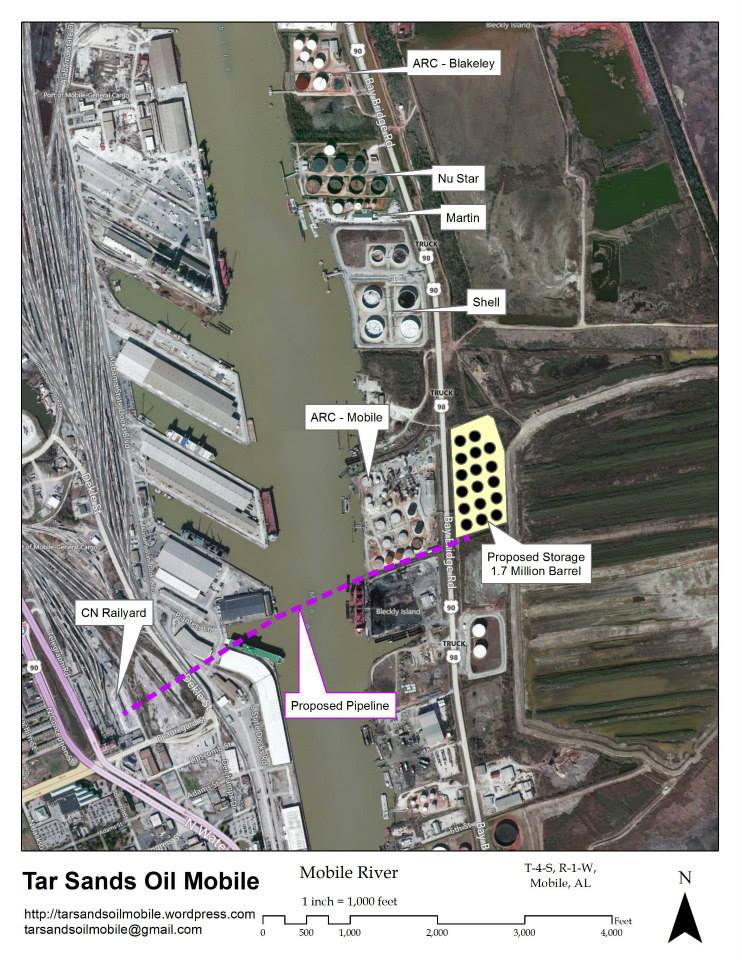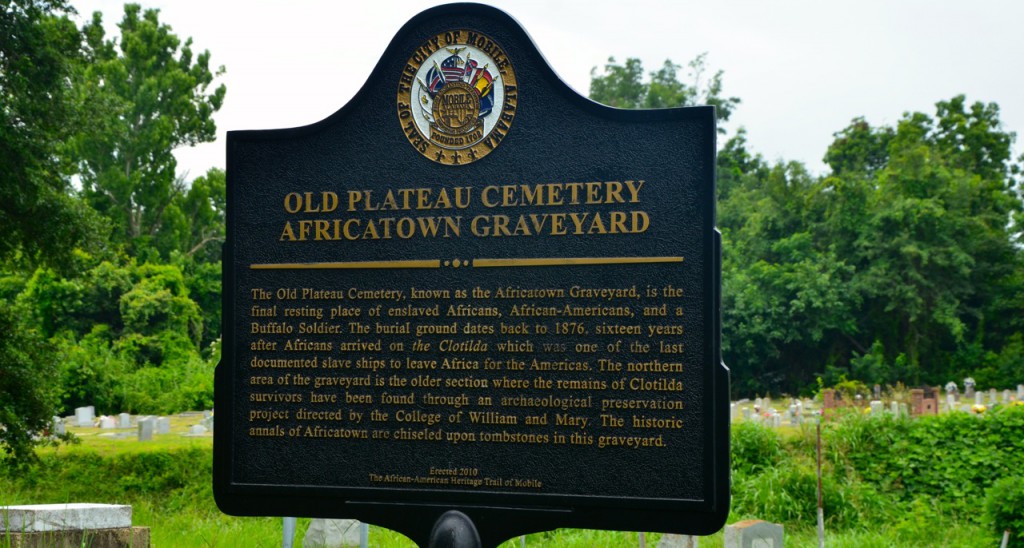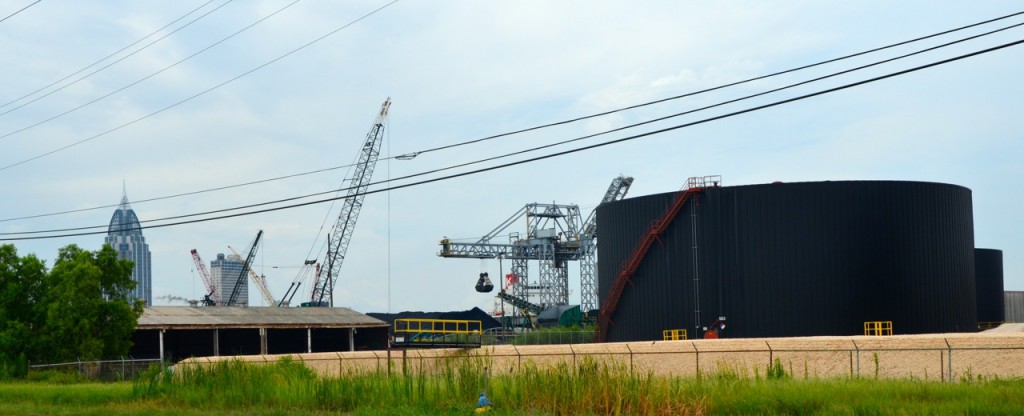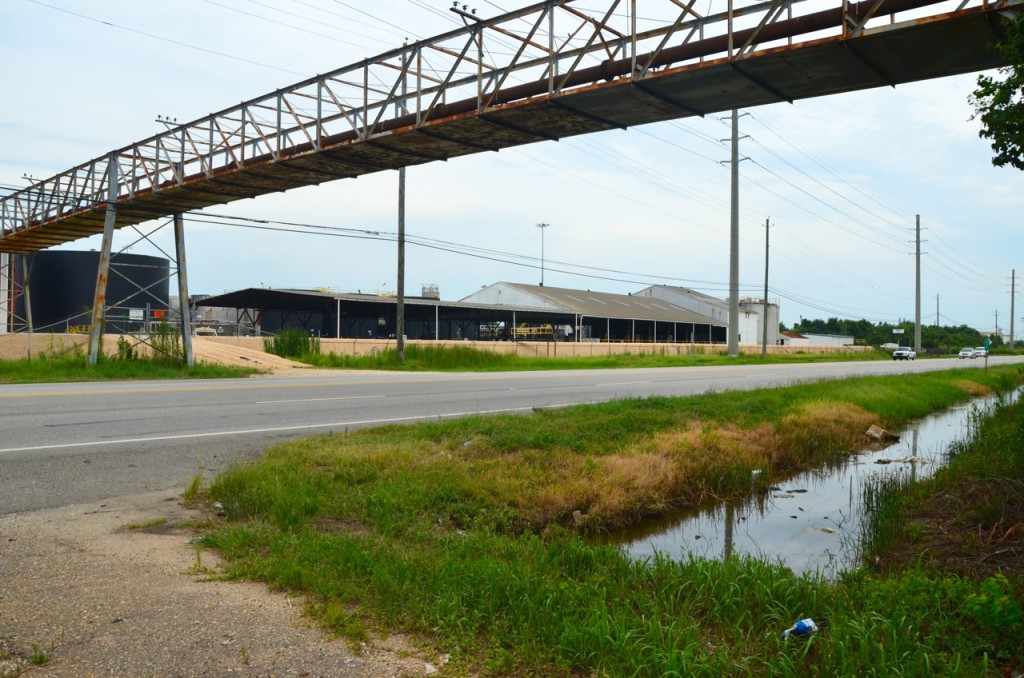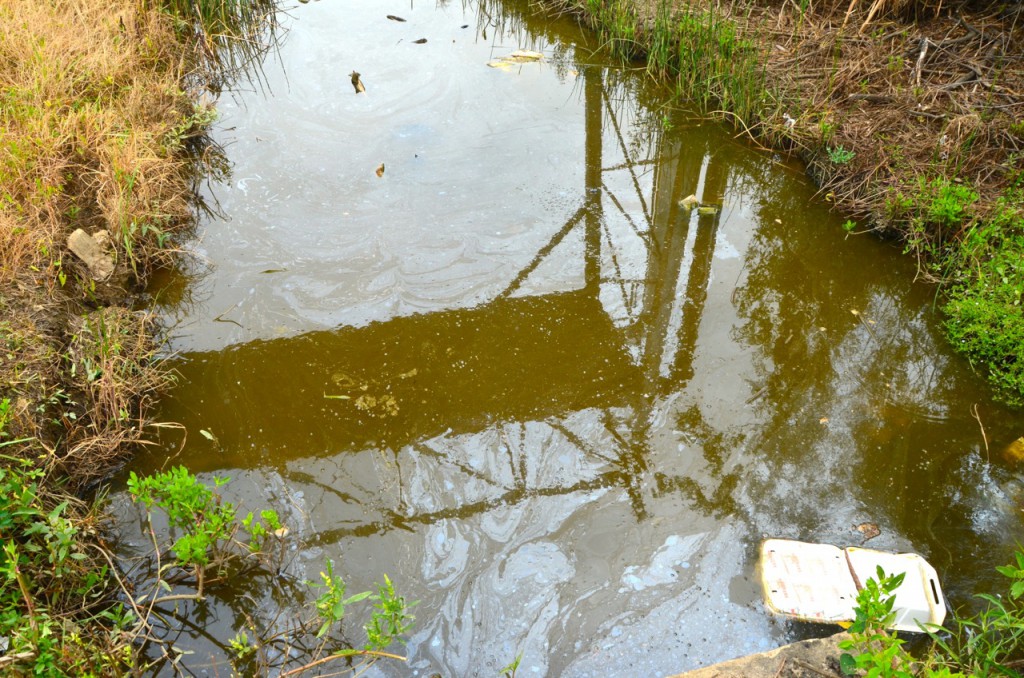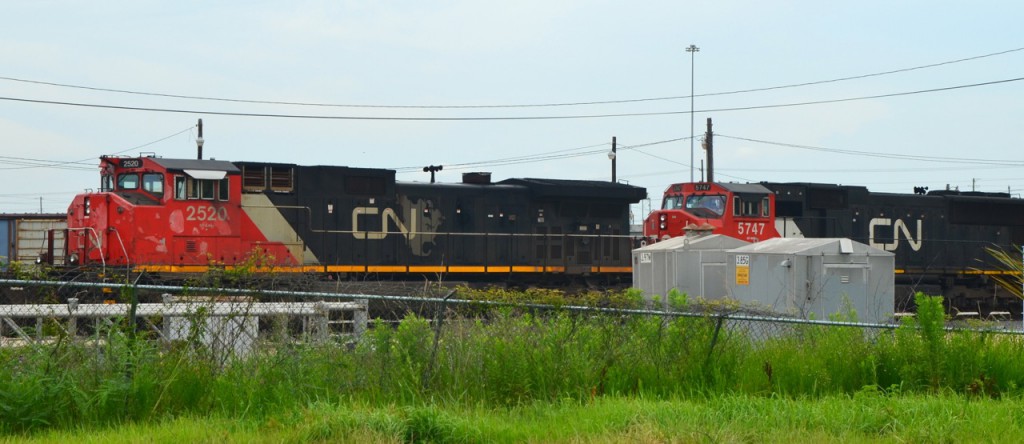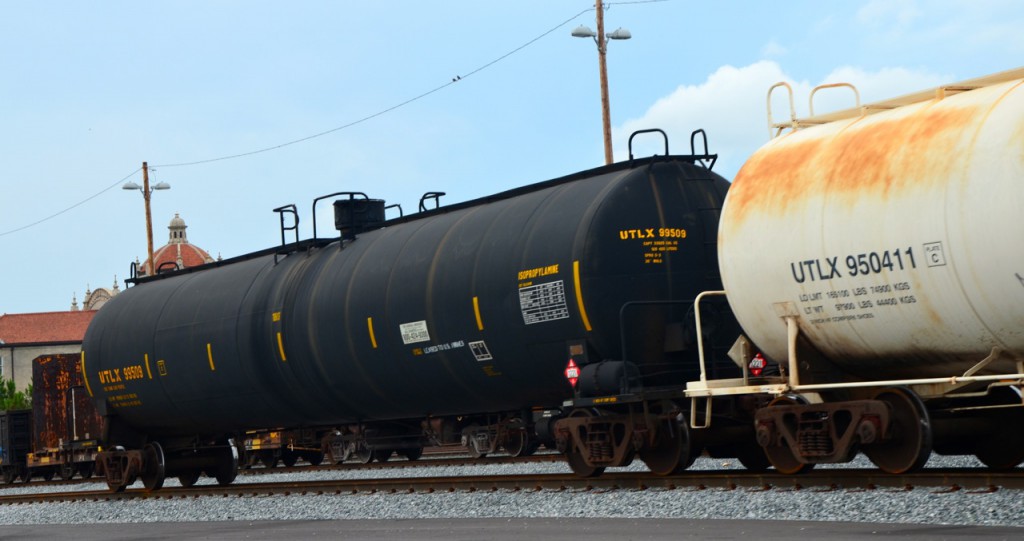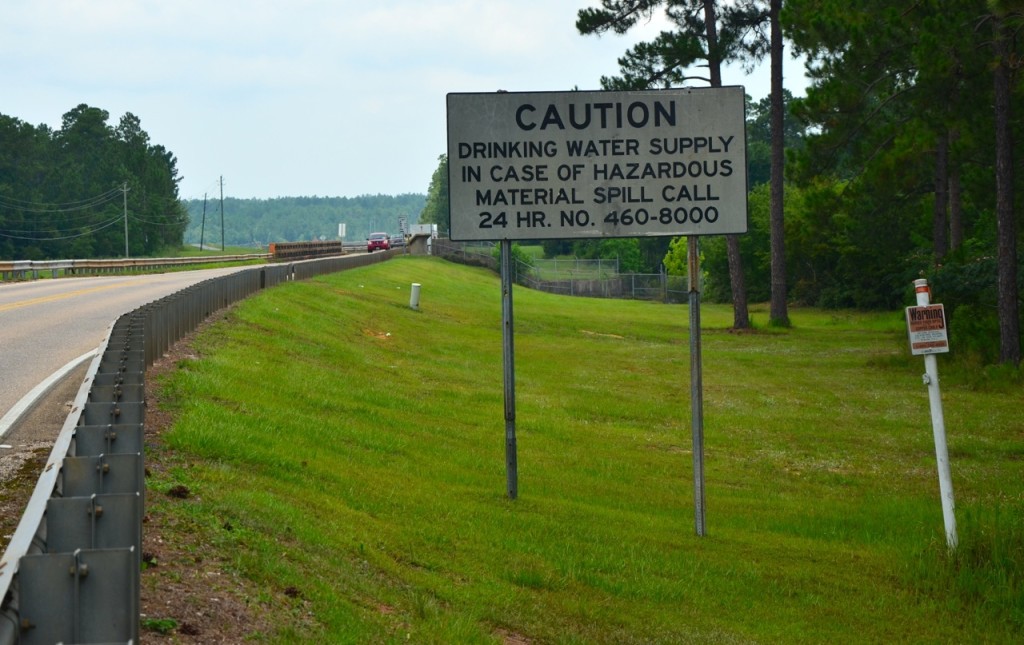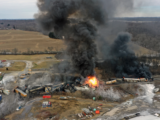Watch the video –
Share the video –
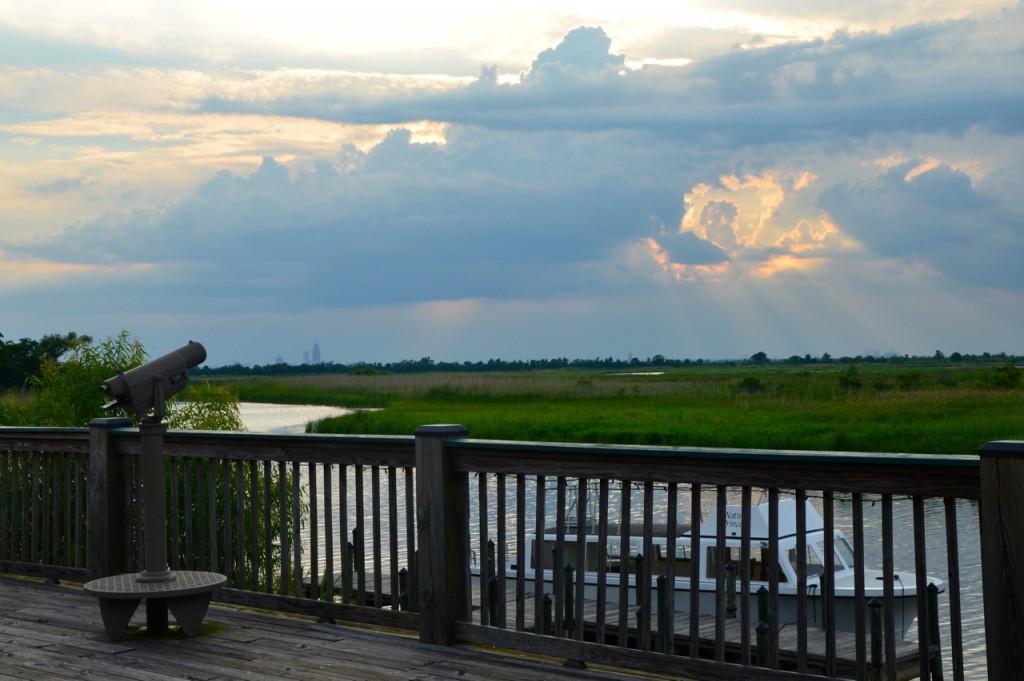
Coming up on sunset on Mobile Bay looking northwest toward the planned pipeline (more photos below – click on the photos for a larger view).
By Glynn Wilson –
MOBILE BAY, Ala. – More than 200 concerned citizens, public officials and environmental activists showed up at a citizens-called town hall public hearing Tuesday night to learn more about a plan to pump thick, hot Canadian tar sands crude oil making its way to the Gulf Coast in rail cars through a new pipeline under the Mobile area’s fresh drinking water reservoir.
Tom Hutchings of EcoSolutions and founder of the Alabama Coastal Foundation moderated the meeting and said when he found out about the pipeline plan, “I was absolutely dumbfounded and mad.”
He showed aerial photographs of the area where the pipeline is in the works, as well as the rail terminal where the Canadian tar sands oil is already making it’s way to the Gulf Coast by train to be exported overseas through the Port of Mobile.
“Air quality, water quality, we’re all for that. But when it comes down to our drinking water that’s something that’s very personal to all of us,” he said. “If we can’t stop the pipeline that’s going to Pascagoula, to Chevron, let’s at least get some safeguards in place. We’ve got to get organized in a way that can be effective.”
This southeastern-most leg of a national tar sands oil pipeline network (see maps below) consists of a 45-mile long, 24-inch pipe carrying crude so thick it has to be heated with natural gas and diluted with other dangerous chemicals. This section along will require 128 permits for wetlands crossings and another 11 permits to cross streams. It has already been approved by the Alabama Public Service Commission, led by former Republican Gov. Bob Riley aide Twinkle Cavanaugh, who received a total of $88,902 in 2012 that can be traced directly to either coal mining companies or political action committees funded primarily by Alabama coal companies.
This pipeline should be halted, by legal or political means — or at least rerouted away from the pristine drinking water source Mobile established for itself many years ago, Big Creek Lake, west of town way out in the country. That was the dominant sentiment in the room, even among the political leadership in the city of Mobile, Mobile County and the Mobile Area Water and Sewer Board. There’s no development around the reservoir, not even a fishing pier, although on an on-the-ground excursion on Wednesday, we did spot two fishing boats in the lake.
Big Creek Lake is a tributary of the Escatawpa River in southwest Alabama and was the subject of controversy in the 1980s over freshwater rights between Alabama and Mississippi. The reservoir and water system, which dates back to 1952, cost $7 million for land, dams, a pumphouse, reservoir and pipelines. It covers 3,600 acres and 103 square miles.
Mobile Mayor Samuel L. Jones, who is facing a reelection fight coming up in August, testified that the Sierra Club and others present knew more about the pipeline plan than city officials. The city was not even notified by the Alabama Department of Environmental Management about the one public hearing held in Montgomery, although Hutchings said while ADEM granted the company a permit for storm water runoff, it’s not in ADEM’s authority to regulate whether the pipeline is built.
“The overall scheme of things is really alarming to me,” Mayor Jones said. “We’ve have not gotten any requests for any permit applications for anything. So a lot of what you are telling us are things we’re learning for the first time. We didn’t know anything about these plans. But you can rest assured that we will go to what extent necessary to protect the watershed.”
Mobile County Commissioner Connie Hudson testified at the hearing. She said Hutchings is right about the drinking water supply being “absolutely critical to this community, for the health, safety, welfare and the future of Mobile County and our whole region.”
“We cannot afford to have a threat such as this to our drinking water supply,” she said, indicating that she only found about about the encroachment of the pipeline on the Big Creek watershed two weeks ago. “That was a call to action for us. This process is flawed, at the federal level as well as the state level. Obviously you don’t have something of this magnitude come into your community and have one public hearing in Montgomery that nobody knows about. I’m angry about that too.”
She said the pipeline route is something local leaders should have known about from the very beginning.
“How was this approved and why did we have no oversight on this?” she asked. “What can we do? We know where we are, which is not good. But the important thing we have to do right now is determine what our options are.”
She and the county planning staff will be having a meeting this week with the company proposing the pipeline, Plains Southcap LLC, and her objective will be to convince the company to reroute the pipeline out of the Big Creek Lake watershed.
It was reported that there has been a problem with the pipe itself, made in Korea, some of which had already been shipped here and stored in advance of all the approvals out in the salty coastal air. It has corroded and cannot be used as a result. That led to a work stoppage order in Semmes (see photos below). Even if the route is not stopped, that pipe will have to be dug up and replaced.
Charles Hyland, director of the Mobile Area Water and Sewer Board, thanked the Sierra Club and the concerned citizens who showed up for helping with “the number one goal, to protect the drinking water supply.”
“There’s only one of them,” he said. “Our board and our entire organization wants to do everything we can to protect the integrity of that water system. Ideally, that would mean that there would be a realignment of this pipeline outside of this watershed.”
He also addressed the issue of putting safeguards into place if the pipeline goes forward.
“What we’re asking for is to look at the way that pipeline is being constructed, the design,” he said. “What kind of safeguards are being taken?”
Larry Godfrey of Wilmer Alabama, who lives very near the pipeline, testified that he was very concerned about it. He talked to the supervisor for the job, he said, who told him about the problems with welding the three-eighths inch-thick pipe. The company plans to dig up what has already been buried in the ground and replace it with new half-inch pipe.
“Supposedly, they’ve discussed going around the watershed,” he said. “Hopefully, that’s what’s going to happen.”
Godfrey indicated that he’s been around since the ’60s and remembers the demonstrations in those days. He’s retired now, he said, and “can afford to go to jail.”
“We’ll get out there on the right-of-way in front of those machines and we’ll stop this project,” he said. “We’ll let Mayor Jones and the County Commission work to stop this project. If that don’t work, we’ll stop it.”
He said the meeting turnout shows him that there are enough people who know what they are doing to fight and kill the pipeline.
“I’ve never seen this many people at a Sierra Club meeting in my life,” he joked, to resounding applause.
One citizen, who did not identify himself, stood up and said while the city and county may not have known about the pipeline, there is no doubt Alabama’s Governor Robert Bentley knew about it and signed off on it, along with the state’s two conservative Republican Senators, Jeff Sessions and Dick Shelby.
“They didn’t let the people know that’s suffering from that pipeline,” he said.
Carol Adams-Davis, an officer with the Alabama Chapter of the Sierra Club, also pointed out that former Alabama Governor Bob Riley is now a lobbyist for Plains Southcap LLC, the company with the contract to build the pipeline, which has made it clear they will require the use of Eminent Domain to obtain private property. They have the authority as a private company thanks to the Alabama Legislature and the U.S. Supreme Court.
The reason for the pipeline in this location, Hutchings said in response to questions from the audience, is that the Canadian National Railroad ends in Mobile, and it would be an added expense to load it onto another train on another company’s lines to ship it to Mississippi. Some of it is now being shipped by barge after it is offloaded at the Arc Terminals in Chickasaw and near downtown Mobile.
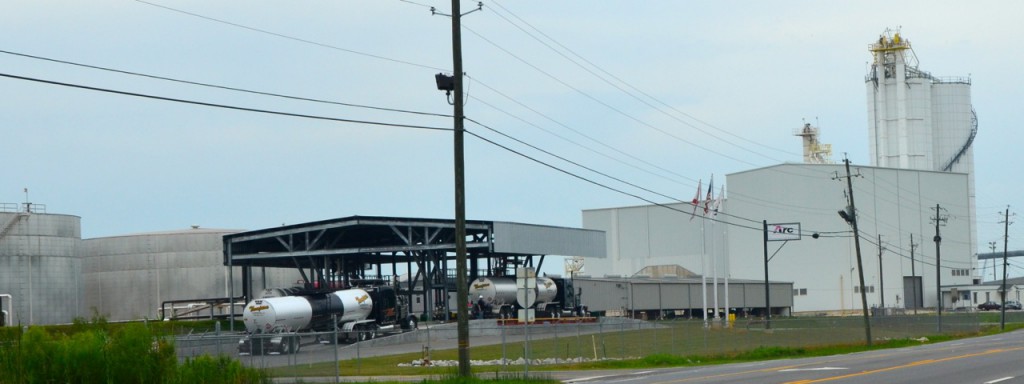
Arc Terminals LP is an independent terminal company that receives and distributes petroleum and petrochemical products throughout the United States via marine, pipeline, rail and truck.
“The petrochemical industry is alive and well in Mobile,” Hutchings said. “We’re not going to change that. But let’s start paying attention and protect the place. It’s time in Mobile, Alabama that we set our culture and our heritage to heavy industry aside and say yes, three or four jobs — putting all of us at risk — is not worth it.”
Expansion of Storage and Transportation Hubs
The public meeting was not just about the pipeline.
Mobile and the state of Alabama are giving massive tax breaks for economic development Downtown, in Africatown, in East Mobile and on the east bank of the Mobile River opposite downtown and the rail yards, where international oil, gas and chemical transportation and storage hubs are being expanded at an alarming rate, local citizens say. Another pipeline is planned to go north from Mobile through Prichard.
Two new tanker storage and export hubs are being planned that could handle 750,000 barrels of tar sands crude — already coming to the Gulf Coast here. If not stopped, this could result in 120 rail cars coming to Mobile full of the thick, hot oil passing through Prichard every day, some of it for export overseas to points around the globe, including India and China.
This would be in addition to the tens of millions of gallons of other petrochemical products stored in tank farms in and around the city, according to Mobile Bay Sierra Club Conservation Chair David Underhill, who pointed out that the amounts being stored in town and to be transported by pipeline “far exceed the amounts of the Exxon Valdez oil spill in Prince William Sound, Alaska.”
“Twenty-five years later it’s still not cleared up,” he said.
The storage tanks lie just a couple of feet above sea level and are at risk from high water and winds in the event of a hurricane.
“Imagine the storm surge from a hurricane 25 or 30 feet high, which is what happened with Katrina, coming up the bay and the river,” he said. This could result in the release of several times more petrochemicals into the environment than the Exxon Valdez, and even the ADEM permit asks if the area is within a projected area of a so-called 100 year flood plain.
“Because we keep burning so much of these fossil fuels, putting them in the atmosphere and disrupting climate so much, the 100 year events tend to happen every five or 10 years,” he said.
Tar sands crude is extracted from strip mines in northern Canada. The volume making its way here by rail will be comparable to what would be delivered by the Keystone XL Pipeline if it’s developed all the way out, Underhill said. Perhaps not quite as much at one time, he indicated, although other rail companies are considering taking it on as well.
So even if activists stop the XL pipeline in places, Canadian tar sands crude is coming to the Gulf Coast for refining and export. It’s not just on the way in large volumes. It’s already here.
“To the extent to which the XL pipeline is stopped (in other states),” he said, “the pressure to bring larger volumes here by train increases.”
He said the tar sands crude is “thicker and worse than ordinary oil, which is bad enough if it gets loose from the pipes.”
“When it comes out of the ground it is thicker than asphalt and has to be diluted by other substances that are by themselves more dangerous than the crude oil in order to make it fluid enough to put it into tanker cars,” he said. “Once it gets here, the plan is to put a flame under each tanker car on the waterfront downtown, a big natural gas flame to heat these tanker cars up to about 180 degrees to make it more fluid to get it through the pipe under the river. So they’re going to pump boiling oil, almost, through the pipeline under the river to these storage tanks.”
Also, he pointed out, if the pressure to divert the pipeline works, it will increase the amount of private property that will have to be seized “by a private company on behalf of the state” through Eminent Domain.
“That’s why we have to stop the whole mess,” he concluded.
The expansion of the tank farms on the waterfront is being promoted by the Industrial Development Board of Mobile, which has granted millions of dollars worth of tax breaks to accommodate it, Underhill pointed out.

Caught fishing in a No Fishing zone in Downtown Mobile. How safe could the crabs be in the middle of all the petrochemicals?
Environmental Racism
Some speakers at the meeting came from Prichard and neighboring communities, although no public officials spoke from Prichard, Chickasaw or Spanish Fort. But the United Association pipefitters union had a representative there. There are rumblings about opposition from organized labor.
Someone from the historic community of Africatown, home to some of the last known slaves illegally shipped to the U.S., spoke out against the pipeline as another example of “environmental injustice” against poor, minority people. Some of the activists who have been fighting the Keystone XL pipeline in Texas also showed up to say they are prepared to come here to physically block the construction if necessary.
Jim Womack from Africatown said the real prize are the tank farms, located in minority communities, where they’ve lived under the shadow of two paper mills for 50 years and now tend to bury their citizens at the age of 40 or 50.
“We don’t want this hazardous stuff around Mobile,” he said. “We want this entire project stopped right now.”
Teresa Bettis, who ran for mayor of Prichard last year, said she was very concerned about the air and water, and was not interested in hearing about shifting the pipeline.
“We don’t want a damn pipeline,” she said.
She’s watched the news about it being stopped in Texas.
“I’ve got a family, my children, and I’m tired of this,” she said. “The Gulf Coast is becoming the dumping ground for every toxic.”
Ramsey Sprague, an activist from Louisiana who has been part of the Keystone XL Pipeline blockade in Texas, went to the microphone and said he didn’t realize the situation here was as bad as it was.
“I’m really, really happy to hear there are people already talking about what’s going to be necessary to take care of the problem,” he said. “We can talk to our local officials. They may mean well. But there are limitations on what they are going to actually be able to do.”
He said they didn’t get much help from local political officials in Texas.
“I’m here to help,” he said, “…to stand up against what we know is environmental racism.”
The native American communities now know, he said, that they are suffering “a slow, industrial genocide because of this tar sands oil, which shouldn’t be called oil at all.”
It is a deadly chemical stew, he said, and no company or government agency, even the Environmental Protection Agency, has “a clue” or a planning regime on how to clean up a spill like the Exxon tar sands oil pipeline rupture and spill in Mayflower, Arkansas this spring.
“The fact there so many people are here is a powerful statement to companies,” he said. “For what it’s worth, we’re going to shut them down.”
The meeting at the Five Rivers Delta Resource Center was organized by the Mobile Bay Sierra Club.
The national Sierra Club is fighting the Keystone XL Pipeline being constructed to bring heavy tar sands crude to the Gulf Coast in part because it is a dirty fossil fuel that contributes to global warming and climate change.
Sierra Club Continues the Fight Against the Keystone XL Tar Sands Pipeline
The Keystone XL Pipeline Map
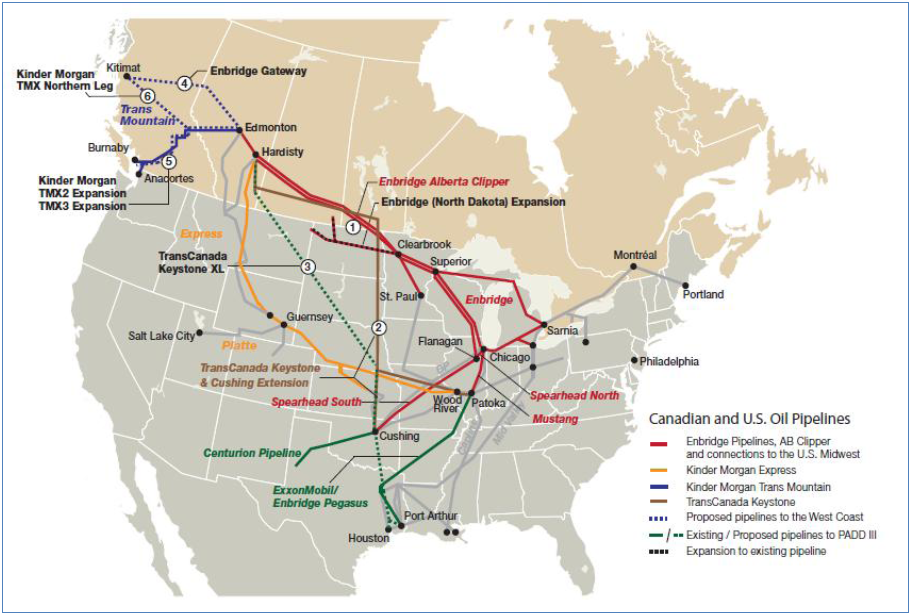
While this map depicts what has come to be known as the controversial Keystone XL Pipeline, what is not shown is that Canadian tar sands crude oil is already making its way to the Gulf Coast by train. Other sections of the national tar sands crude network of pipelines have received less attention, like the one in Mobile
See our previous coverage about the Mobile pipeline issue here: Proposed Oil Pipelines To Run Through Mobile’s Drinking Water Supply
Related coverage: REALITY CHECK: Why Local Leaders Didn’t Know an Oil Pipeline was Approved Near Mobile’s Drinking Water Supply
More Photographs
Five Rivers Delta Resource Center
After the meeting, Wednesday morning, Mobile Bay Sierra Club conservative chair David Underhill led a driving tour of the southern end of the Keystone XL pipeline, the route, rail and port facilities where Canadian tar sands crude oil is already flooding into the area by train. If this end of the pipeline goes through, projections indicate there could be 120 rail cars of the thick, hot oil flowing here every day, shipped overseas to points around the globe, including India and China.
Here are a few of the photos from that trip (click on the images for a larger view)..
More information on the history of Big Creek Lake from Wikipedia
Canada to U.S. Oil Pipeline Map


